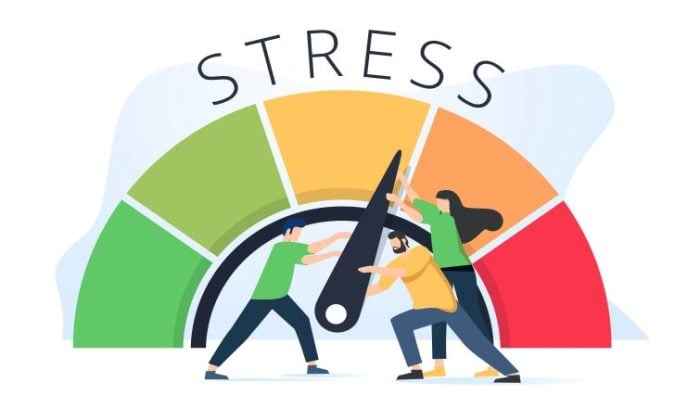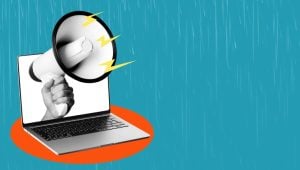The Most Stressful Jobs in 2021
 Publié le 16 November 2021
Publié le 16 November 2021
By examining recent reports listing the most stressful jobs in 2021, employers and job seekers in these industries can work together to reduce workplace stress and create a better work environment.
Stress is a serious problem, and workplace stress in particular can have a negative impact on all impacts of a person’s life. Chronic levels of stress can harm the emotional, mental and physical life-being of people, make maintaining a proper work-life balance almost impossible, and hinder a business’ ability to grow and succeed.
LifeWorks has released their September 2021 Mental Health Index report, which includes a breakdown of the percentage of employees in over 20 industries who report feeling chronic workplace stress. When comparing these numbers to LifeWorks September 2020 Mental Health Index reports it is possible to track changes over the past year.
Reducing stress is most important for health and well-being reasons, and doing so will also have benefits for a business’ bottom line. Studies have shown that businesses lose a combined total of hundreds of billions of dollars in a year due to the side effects of stress. Employers and employees must work together to reduce stress, as it will benefit everyone. Reviewing the most stressful jobs in 2021 is a good place to begin.
Workplace Stress and COVID-19
Workplace stress has been steadily rising over the past decade, but the ongoing COVID-19 pandemic only served to amplify these effects. As employees and employers have found themselves constantly readjusting to constantly changing professional and personal circumstances over the past 18 months, stress and anxiety have gotten worse for people in all job industries and sectors. As workers try to settle into some new or altered version of work, a key priority must be finding different and more effective methods to manage workplace stress. If employers are not prepared to provide the flexibility needed to reduce workplace stress, at least 39% of workers are prepared to leave their job for one that will do so.
Side Effects of Stress
According to the Mayo Clinic, some of the common effects of chronic stress include:
- Headaches and migraine
- Insomnia and sleeping issues
- Muscle tension and pain
- Difficulty concentrating
- Anxiety and depression
- High blood pressure
- Increased chance of heart attacks and strokes
Chronic stress can have negative consequences on physical, mental and emotional health which can potentially be life threatening. A recent 2020 study found that chronic stress can even reduce life expectancy by 2.8 years. Addressing and reducing stress not only offer benefits in the short term but can have very real effects on people’s lives. For people considering their professional future, the negative consequences of chronic stress in both their professional and personal lives no doubt plays a role in which career path they select.
The Most Stressful Jobs in 2021*
| INDUSTRY | 2021 % | 2020 % | CHANGE % |
| Arts, Entertainment and Recreation | 63.4 | 57.9 | +5.5 |
| Health Care and Social Assistance | 60.7 | 58.0 | +2.7 |
| Wholesale Trade | 59.5 | 58.8 | +0.7 |
| Information and Cultural Industries | 58.9 | 57.5 | +1.4 |
| Educational Services | 58.9 | 60.3 | -1.4 |
| Automotive Industry | 58.5 | 56.1 | +2.4 |
| Mining and Oil and Gas Extraction | 57.4 | 52.0 | +5.4 |
| Accommodation and Food Services | 57.4 | 60.7 | -3.3 |
| Retail Trade | 56.8 | 56.6 | +0.2 |
| Manufacturing | 56.5 | 55.8 | +0.7 |
| Construction | 56.4 | 55.1 | +1.3 |
| Public Administration | 56.3 | 56.6 | -0.3 |
| Full-time student | 56.1 | 61.3 | -5.2 |
| Real Estate, Rental and Leasing | 56.1 | 54.0 | +2.1 |
| Management of Companies and Enterprises | 55.9 | 60.7 | -4.8 |
| Finance and Insurance | 55.2 | 58.8 | -3.6 |
| Utilities | 54.8 | 61.4 | -6.6 |
| Professional, Scientific and Technical Services | 54.6 | 55.1 | -0.5 |
| Transportation and Warehousing | 54.1 | 59.1 | -5.0 |
| Agriculture, Forestry, Fishing and Hunting | 53.8 | 54.0 | -0.2 |
| Other | 51.7 | 51.3 | +0.4 |
| Other services except public administration | 51.1 | 56.0 | -4.9 |
Highest Levels of Stress
The most stressful jobs in 2021 are those that are still the most directly affected by the ongoing COVID-19 pandemic. The most stressful jobs are found in the “Arts, Entertainment and Recreation” sector, which has experienced necessary restrictions and reduced government support longer than most other sectors.
Workers in the “Health Care and Social Assistance” sector are the second most stressed, after more than nearly two years of dealing firsthand with the devastating COVID-19 pandemic while often putting their own health at risk. Employees in the “Wholesale Trade and Education Services” sector also report high levels of stress, linked to global supply issues and the difficulty of adapting initially to virtual learning and then to altered in-person learning environments.
| HIGHEST STRESS | 2021 % |
| Arts, Entertainment and Recreation | 63.4 |
| Health Care and Social Assistance | 60.7 |
| Wholesale Trade | 59.5 |
| Educational Services | 58.9 |
| Information and Cultural Industries | 58.9 |
Lowest Level of Stress
The least stressful jobs in 2021 fall under the broad categories of “Other services except public administration” and “Other”. These are followed by “Agriculture, Forestry, Fishing and Hunting” and “Transportation and Warehousing”, at 53.8% and 54.1% respectively. While these industries are not without challenges in 2021, they provide services that are often considered essential and therefore have not been subject to the same level or duration of restrictions as other job sectors.
It is important to note that the lowest level of stress reported in this study is 51.1%. This means that even in industries the most far from the top of the list of the most stressful jobs in 2021, over half of all employees in every single industry report feeling stressed on a regular basis. When a majority of employees acknowledge the impact and reality of chronic stress, it speaks to larger issues that employers and employees must work together to address and mitigate as much as possible.
| LOWEST STRESS | 2021 % |
| Other services except public administration | 51.1 |
| Other | 51.7 |
| Agriculture, Forestry, Fishing and Hunting | 53.8 |
| Transportation and Warehousing | 54.1 |
| Professional, Scientific and Technical Services | 54.6 |
Biggest Workplace Stress Increase
Even though the discussion surrounding the negative impact of chronic workplace stress on mental well-being and the need to address it has become more open, there has still been an increase in workplace stress over the past year. Comparing the statistics from 12 months apart, the largest increase has been experienced by those in the “Arts, Entertainment, and Recreation” industry, where the number of people experiencing stress rose by 5.5%. This is followed closely by the “Mining and Oil and Gas Extraction,” with a 5.4% stress increase. Of interesting note is that “Arts…” is the most stressful job sector after this increase, while “Mining…” only reached 16 of 22 industries despite an almost equally large stress increase.
The “Health Care and Social Assistance” sector experienced the third largest increase of 2.7%. While this increase is only half the size of the top two, it is likely due to the fact that the healthcare sector already experienced a high level of stress, and is the second most stressful job in 2021 overall. Data from Statistics Canada shows that 56% of healthcare workers described their average day as “quite a bit stressful” or “extremely stressful.”
| STRESS INCREASE | 2021 % | 2020 % | CHANGE % |
| Arts, Entertainment and Recreation | 63.4 | 57.9 | +5.5 |
| Mining and Oil and Gas Extraction | 57.4 | 52.0 | +5.4 |
| Health Care and Social Assistance | 60.7 | 58.0 | +2.7 |
| Automotive Industry | 58.5 | 56.1 | +2.4 |
| Information and Cultural Industries | 58.9 | 57.5 | +1.4 |
Biggest Workplace Stress Decrease
The biggest decrease in workplace stress was found in the “Utilities” sector, with a 6.6%, followed by “Full-time student” with a 5.2%. The drop in stress for students is likely related to the return of in-person learning. The previous year found the majority of students having to quickly adapt to at-home learning, with all the ensuing technical complications, and deal with the uncertainty of not knowing when they would be required to return to the classroom.
People working in “Management of Companies and Enterprises” also experienced a significant drop in stress, with a 4.8% decrease. Over a year and half after many workplaces rapidly transitioned to remote working arrangements, it appears that many managers have adapted to the change. By listening to the needs and wants of employees, realizing that what worked in the traditional office doesn’t always work remotely, and taking steps to ensure that remote workers feel supported has helped everyone adjust to these new working arrangements. With many businesses now navigating a return to the office or implementing flexible hybrid work arrangements, managers must again work proactively to adapt in order to avoid unnecessary workplace stress.
| STRESS DECREASE | 2021 % | 2020 % | CHANGE % |
| Utilities | 54.8 | 61.4 | -6.6 |
| Full-Time Student | 56.1 | 61.3 | -5.2 |
| Transportation and Warehousing | 54.1 | 59.1 | -5.0 |
| Other services except public administration | 51.1 | 56.0 | -4.9 |
| Management of Companies and Enterprises | 55.9 | 60.7 | -4.8 |
Workplace stress spells trouble for everyone. It’s bad for employee well-being and it’s bad for the future success of a company. The LifeWorks Mental Health Index provides insight to the stress experienced by people working in a wide variety of industries and job sectors. By understanding and evaluating the most stressful jobs in 2021, it is possible for employees and employers to recognize this as a serious problem and work to reduce stress in the workplace.







